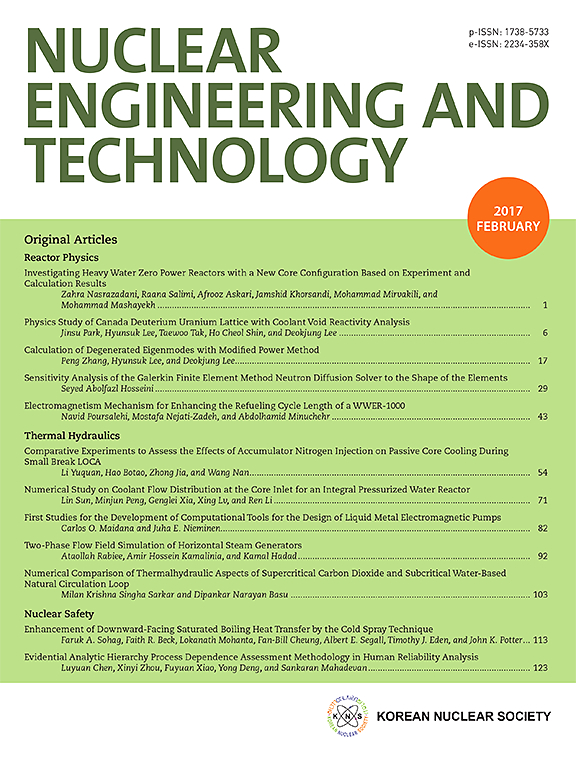Assessment of pressurizer dynamic performance for nuclear hybrid energy system modelling: Comparison between equilibrium and 1D non-equilibrium approaches
IF 2.6
3区 工程技术
Q1 NUCLEAR SCIENCE & TECHNOLOGY
引用次数: 0
Abstract
The importance of the pressurizer for the control and safe operation of pressurized water reactors translates into the need to develop accurate dynamic models to simulate the response of this component in various scenarios. This study compares two modelling paradigms, classified into equilibrium and non-equilibrium approaches, implemented in the Modelica language. Specifically, the non-equilibrium version adopts a 1D modelling approach with a user-defined number of control volumes. The objective is to assess the prediction accuracy by comparing simulation results with experimental data. The analysis identifies the models’ applicability limits as well a relevant phenomena affecting the outcomes. Additionally, the investigation is extended to a Small Modular Reactor (SMR) pressurizer architecture, exploring the impact of its features and different control strategies to mitigate pressure fluctuations. The latter analysis represents an initial step towards the development of a SMR-driven integrated energy system simulator, which will encompass the most suitable pressurizer model. The outcomes of this work indicate that the equilibrium model is able to capture overall system dynamics despite its strong simplifying assumptions. As for the SMR pressurizer, the distinctive geometry affects the system’s response to the considered transients, resulting in the requirement of designing control strategies tailored to its characteristics.
核能混合能源系统建模的稳压器动态性能评估:平衡与一维非平衡方法的比较
稳压器对压水堆的控制和安全运行的重要性转化为需要开发精确的动态模型来模拟该组件在各种情况下的响应。本研究比较了两种建模范式,分为均衡和非均衡方法,在Modelica语言中实现。具体而言,非平衡版本采用一维建模方法,具有用户定义的控制体积数量。目的是通过比较模拟结果和实验数据来评估预测的准确性。分析确定了模型的适用范围以及影响结果的相关现象。此外,研究扩展到小型模块化反应堆(SMR)稳压器结构,探索其特性和不同控制策略的影响,以减轻压力波动。后一种分析是朝着smr驱动的综合能源系统模拟器的发展迈出的第一步,该模拟器将包含最合适的稳压器模型。这项工作的结果表明,均衡模型能够捕捉整体系统动力学,尽管它的强简化假设。至于SMR稳压器,其独特的几何形状会影响系统对所考虑的瞬态响应,因此需要根据其特性设计量身定制的控制策略。
本文章由计算机程序翻译,如有差异,请以英文原文为准。
求助全文
约1分钟内获得全文
求助全文
来源期刊

Nuclear Engineering and Technology
工程技术-核科学技术
CiteScore
4.80
自引率
7.40%
发文量
431
审稿时长
3.5 months
期刊介绍:
Nuclear Engineering and Technology (NET), an international journal of the Korean Nuclear Society (KNS), publishes peer-reviewed papers on original research, ideas and developments in all areas of the field of nuclear science and technology. NET bimonthly publishes original articles, reviews, and technical notes. The journal is listed in the Science Citation Index Expanded (SCIE) of Thomson Reuters.
NET covers all fields for peaceful utilization of nuclear energy and radiation as follows:
1) Reactor Physics
2) Thermal Hydraulics
3) Nuclear Safety
4) Nuclear I&C
5) Nuclear Physics, Fusion, and Laser Technology
6) Nuclear Fuel Cycle and Radioactive Waste Management
7) Nuclear Fuel and Reactor Materials
8) Radiation Application
9) Radiation Protection
10) Nuclear Structural Analysis and Plant Management & Maintenance
11) Nuclear Policy, Economics, and Human Resource Development
 求助内容:
求助内容: 应助结果提醒方式:
应助结果提醒方式:


